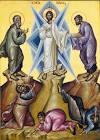
Peter had proclaimed Jesus as the Messiah in response to his question: “But who do you say that I am?” (Luke 9:20) It was after this that Jesus led the three disciples up the mountain. It is not surprising that Peter, leader of the apostles, was one of them, but why James and John? Perhaps they were the most influential members of the group and would be listened to when the time came for them to share their experience with the others.
Only Luke describes Jesus as praying when he was transfigured. He was still the same person but his friends now saw a glimpse of the majesty of their master and friend. It was a vision that would sustain them when they saw the bloody, mangled figure on the cross: “As the crowd were appalled on seeing him - so disfigured did he look that he seemed no longer human...” (Isaiah 52:14)
Generally we, like the disciples, lead fairly ordinary lives. Occasionally we are given moments of mystical insight, as were they. These moments do not last but their effects do and are often life-changing. For St Juliana of Liege it was her vision of the moon, with a dark stripe across it, which impelled her to campaign to have a special feast day for the Eucharist. For St Ignatius it was his vision of Christ, carrying his cross, at the wayside shrine of La Storta, which confirmed him in his resolve to serve him - along with his companions - in what became known as the Society of Jesus.
In these days of darkness - when we witness the indiscriminate slaughter of the innocent, the destruction of cities and the homelessness of millions - we have to look beyond ourselves to see God working through the mess of human devastation.